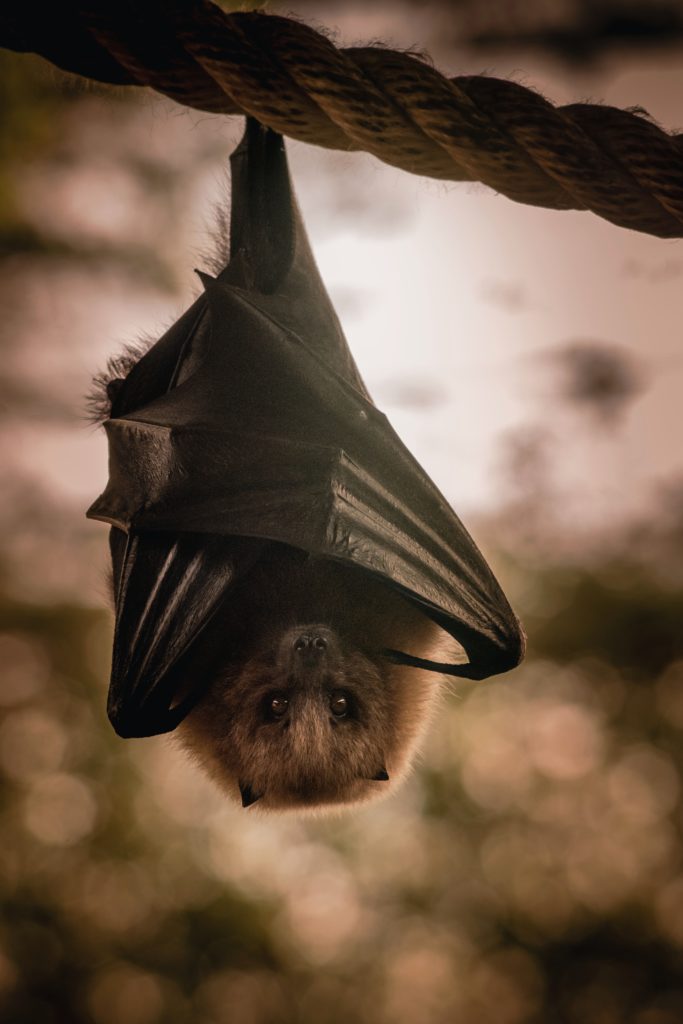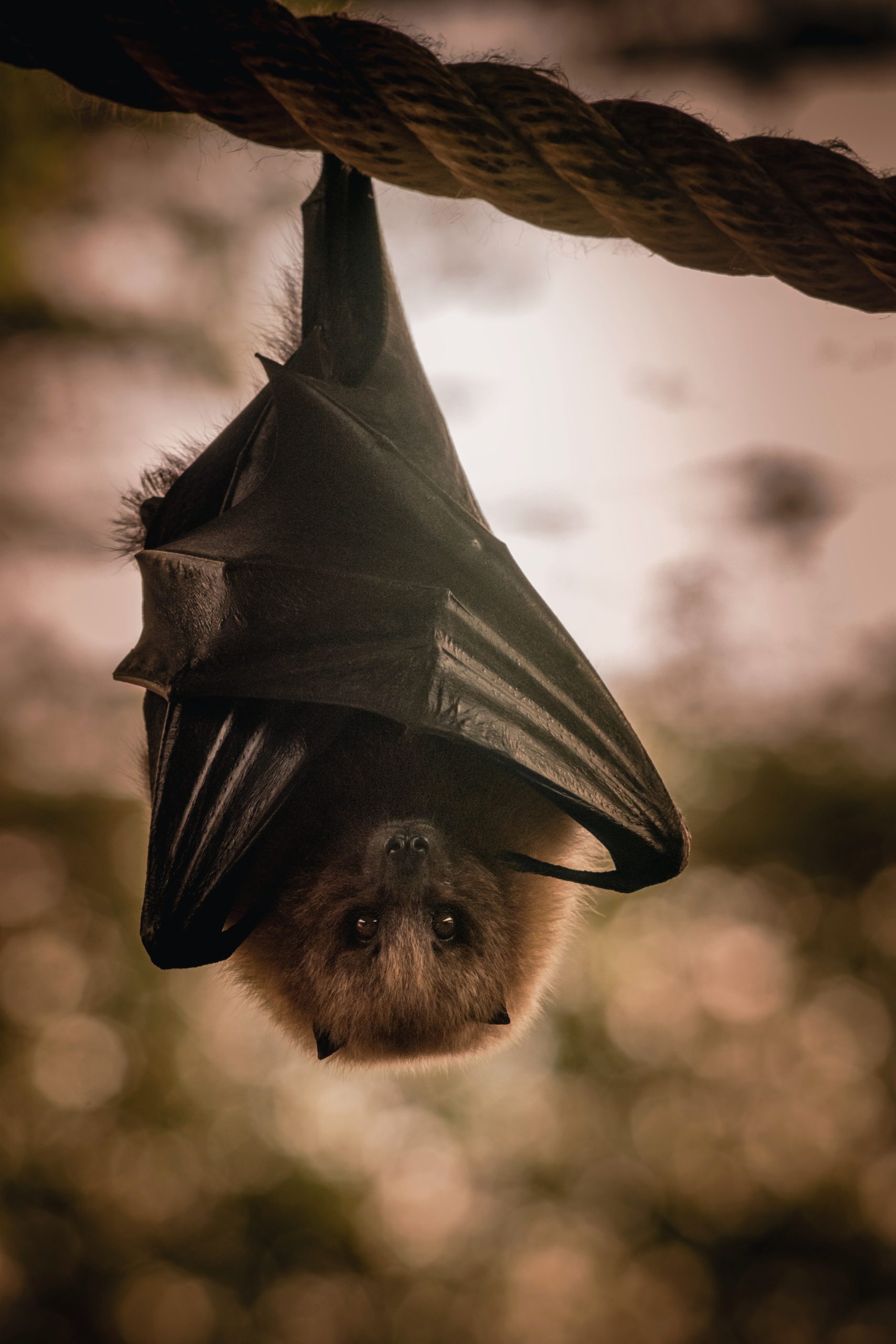
I learned this today. Bats can sleep hanging upside down because they need to use muscles to open their claws but not to keep them closed.
The main reason that bats sleep hanging upside down is because they are not very good at taking off from the ground. In order to fly, bats have to drop from a height of at least 1m. They can’t take off from the ground because of their bones, their knees, and their wings. Bats are mammals and, as mammals, they have flat, solid bones. Birds have hollow bones. This makes bats heavier for their size than a bird would be.
Coupled with this, the knees on a bat point backwards. This is useful for hanging, as we shall see, but it is not much use for a ground take off. Birds usually have two methods to take off. They will either run to pick up speed or jump to give themselves a boost into the sky. Bats can’t do this. Because their knees point backwards, they can’t run or jump. Bats move along the ground by using their forearms and wings to drag themselves along. They cannot get up any speed and they cannot leap into the sky.
Even if bats could run to gather speed or leap into the sky, their wings don’t give them enough lift. Birds have very strong breast muscles that are attached to their wings. They can use these muscles to produce a lot of lift. If a bird jumps off the ground and flaps its wings, it is going to go up. If a bat could jump off the ground and flapped its wings, it would just come down again. Bats only have one muscle that attaches the wings to the breastbone. Bats don’t have as much lift as birds, but their wings are far more flexible. Once they are flying, they are more mobile than birds and can fly upside down, weave in and out of trees, and turn sharply by applying sudden brakes. Birds cannot do this.
Because bats need to be able to drop into flight and they wouldn’t be able to take off if they slept on the ground, they have evolved to sleep hanging upside down. When they wake up, or if they are attacked, they can just drop and fly away.
So, how can they sleep hanging upside down? There are three things that allow them to do it. Firstly, their claws. If you or I want to hang from a beam, we have to contract our muscles to make our hands grip the beam. Contracting a muscle is tiring because of neural fatigue and metabolic fatigue. It is hard for the nerves to keep sending signals to tell the brain to keep the muscle contracted and waste products build up in the muscle. Because of this, we find it hard to understand how a bat would be able to hang upside down without feeling muscle fatigue. Their claws allow them to hang upside down because they are built the opposite way to us. Their knees point backwards, and their claws shut when their muscles are relaxed. They have to contract their muscles to open their claws. That means, when they are hanging by their feet, their muscles relax and keep their claws shut. Bats will still hang there even after they have died.
The second thing is their blood circulation. Again, if we were to hang upside down, blood would pool in our heads. We have evolved a circulation that tries to keep blood from pooling in our feet. It doesn’t work the other way around. Also, our lungs only work if they are on top of our other organs. If we are upside down for too long, the weight of our other organs will suffocate us. Bats don’t have this problem. They are very small which means it is easier for their heart to distribute their blood. They also have one-way valves in their arteries to stop the blood from flowing backwards.
And, thirdly, their flexible wings allow them to land upside down on the roof of a cave. They fly into the cave and retract one wing when they get close to their perch while still flapping the other wing. This rotates their bodies and flips them upside down. A bird could never do this. If they miss their perch, they can easily flip their bodies over and glide down to make another attempt.
So, bats can sleep hanging upside down because their leg muscles open their claws, not close them. By hanging there, gravity keeps their claws shut, gripping their perch. They don’t have a lot of blood to circulate, but they also have one-way valves to make sure the blood doesn’t flow back. They have extremely flexible wings which allow them to land upside down. They have to sleep hanging upside down because they are not capable of taking off from the ground and have to drop into flight. And this is what I learned today.
Photo by Stephen Chantzis from Pexels
Sources
https://en.wikipedia.org/wiki/Bat
https://www.iowadnr.gov/About-DNR/DNR-News-Releases/ArticleID/1082/Why-do-bats-hang-upside-down
https://www.mentalfloss.com/article/574568/why-do-bats-hang-upside-down
https://www.terminix.com/blog/education/do-bats-sleep-upside-down/
https://www.terminix.com/blog/education/do-bats-sleep-upside-down/
https://www.batworlds.com/bat-anatomy/
https://smallscience.hbcse.tifr.res.in/how-bats-fly/
https://animals.howstuffworks.com/mammals/how-bats-land-upside-down.htm
https://en.wikipedia.org/wiki/Muscle_fatigue

